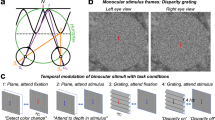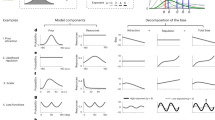Abstract
Differences between the left and right eye's views of the world carry information about three-dimensional scene structure and about the position of the eyes in the head. The contemporary Bayesian approach to perception1, 2 implies that human performance in using this source of eye-position information can be analysed most usefully by comparison with the performance of a statistically optimal observer. Here we argue that the comparison observer should also be statistically robust, and we find that this requirement leads to qualitatively new behaviours. For example, when presented with a class of stereoscopic stimuli containing inconsistent information about eccentricity of gaze, estimates of this gaze parameter recorded from one robust ideal observer bifurcate at a critical value of stimulus inconsistency. We report an experiment in which human observers also show this phenomenon and we use the experimentally determined critical value to estimate the vertical acuity of the visual system. The Bayesian analysis also provides a highly reliable and biologically plausible algorithm that can recover eye positions even before the classic stereo-correspondence problem is solved, that is, before deciding which features in the left and right images are to be matched.
This is a preview of subscription content, access via your institution
Access options
Subscribe to this journal
Receive 51 print issues and online access
$199.00 per year
only $3.90 per issue
Buy this article
- Purchase on Springer Link
- Instant access to full article PDF
Prices may be subject to local taxes which are calculated during checkout




Similar content being viewed by others
References
Knill, D. C. & Richards, W. Perception as Bayesian Inference (Cambridge Univ. Press, Cambridge, (1996).
Adelson, E. H. & Weiss, Y. Asimple Bayesian model predicts a complex set of phenomena. Perception 27 (Suppl.), 18 (1980).
Barlow, H. The absolute efficiency of perceptual decisions. Phil. Trans. R. Soc. Lond. B 290, 71–82 (1980).
Gårding, J., Porrill, J., Mayhew, J. E. W. & Frisby, J. P. Stereopsis, vertical disparity and relief transformations. Vision Res. 35, 703–722 ( 1995).
Koenderink, J. J. & van Doorn, A. J. Geometry of binocular vision and a model for stereopsis. Biol. Cybern. 21, 29–35 (1976).
Petrov, A. P. Ageometrical explanation of the induced size effect. Vision Res. 20, 409–416 ( 1980).
Mayhew, J. E. W. The interpretation of stereo-disparity information: the computation of surface orientation and depth. Perception 11, 387 –403 (1982).
Mayhew, J. E. W. & Longuet-Higgins, H. C. Acomputation model of binocular depth perception. Nature 297, 376–379 (1982).
Frisby, J. P. An old illusion and a new theory of stereoscopic depth perception. Nature 307, 592–593 ( 1984).
Porrill, J., Mayhew, J. E. W. & Frisby, J. P. in Frontiers of Visual Science: Proceedings of the 1985 Symposium 90–108 (National Academy Press, Washington DC, (1985).
Ogle, K. N. in The EyeVol. 4 Part II (ed. Davson, H.) 209–417 (Academic, New York, (1962).
Stenton, P., Frisby, J. P. & Mayhew, J. E. W. Vertical disparity pooling and the induced effect. Nature 309, 622–623 (1984).
Adams, W. et al. Pooling of vertical disparity information in the human visual system. Perception 25, 165– 176 (1996).
Drasdo, N. The neural representation of visual space. Nature 266 , 554–556 (1977).
van de Grind, W. A., Erkelens, C. J. & Laan, A. C. Binocular correspondence and visual direction. Perception 24, 215–235 ( 1995).
Rogers, B. J. & Bradshaw, M. F. Does the visual system use the epipolar constraint for matching binocular images? Invest. Opthalmol. Vis. Sci. 37, 684 (1996).
Stephenson, S. B. & Schor, C. M. Human stereo matching is not restricted to epipolar lines. Vision Res. 37, 2717–2723 (1997).
Stephens, R. S. The probabilistic Hough transform. Image Vision Comput. 9, 66–71 (1991).
Ballard, D. H. Generalising the Hough transform to detect arbitrary shapes. Pattern Recog. 13, 111–122 ( 1981).
Peek, S., Mayhew, J. E. W. & Frisby, J. P. Obtaining viewing distance and angle of gaze from vertical disparities using a Hough-type accumulator. Image Vision Comput. 2, 180–190 ( 1984).
Ballard, D. H. Cortical connections and parallel processing: structure and function. Behav. Brain Sci. 9, 67–120 (1986).
Marr, D. Vision (Freeman, San Francisco, (1982).
Kaneko, H. & Howard, I. P. Spatial limitation of vertical-size disparity processing. Vision Res. 37, 2871 –2878 (1997).
Kay, S. M. Fundamentals of Signal Processing—Estimation Theory (Prentice Hall International, New Jersey, (1993).
Porrill, J. & Frisby, J. P. Computation of binocular eye position from vertical disparities with the use of probabilistic plac
Author information
Authors and Affiliations
Rights and permissions
About this article
Cite this article
Porrill, J., Frisby, J., Adams, W. et al. Robust and optimal use of information in stereo vision. Nature 397, 63–66 (1999). https://doi.org/10.1038/16244
Received:
Accepted:
Issue Date:
DOI: https://doi.org/10.1038/16244
This article is cited by
-
3-D Depth Reconstruction from a Single Still Image
International Journal of Computer Vision (2008)
Comments
By submitting a comment you agree to abide by our Terms and Community Guidelines. If you find something abusive or that does not comply with our terms or guidelines please flag it as inappropriate.



